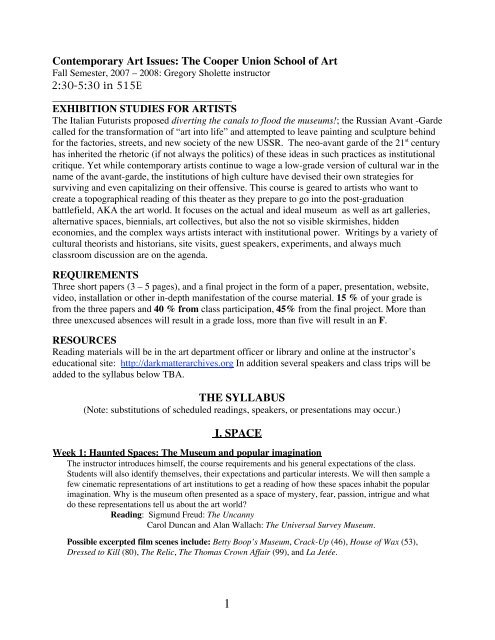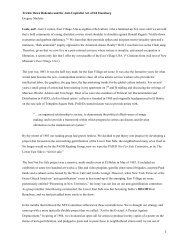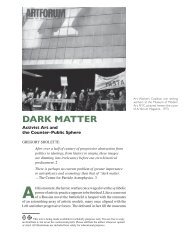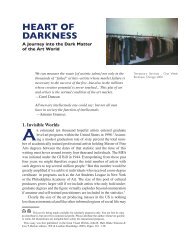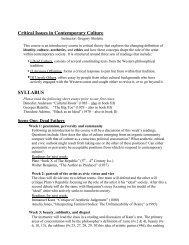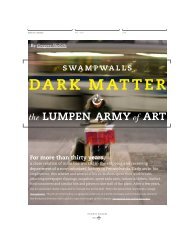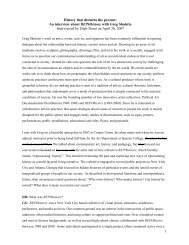Contemporary Art Issues: The Cooper Union ... - Gregory Sholette
Contemporary Art Issues: The Cooper Union ... - Gregory Sholette
Contemporary Art Issues: The Cooper Union ... - Gregory Sholette
Create successful ePaper yourself
Turn your PDF publications into a flip-book with our unique Google optimized e-Paper software.
<strong>Contemporary</strong> <strong>Art</strong> <strong>Issues</strong>: <strong>The</strong> <strong>Cooper</strong> <strong>Union</strong> School of <strong>Art</strong><br />
Fall Semester, 2007 – 2008: <strong>Gregory</strong> <strong>Sholette</strong> instructor<br />
2:30-5:30 in 515E<br />
_____________________________________<br />
EXHIBITION STUDIES FOR ARTISTS<br />
<strong>The</strong> Italian Futurists proposed diverting the canals to flood the museums!; the Russian Avant -Garde<br />
called for the transformation of “art into life” and attempted to leave painting and sculpture behind<br />
for the factories, streets, and new society of the new USSR. <strong>The</strong> neo-avant garde of the 21 st century<br />
has inherited the rhetoric (if not always the politics) of these ideas in such practices as institutional<br />
critique. Yet while contemporary artists continue to wage a low-grade version of cultural war in the<br />
name of the avant-garde, the institutions of high culture have devised their own strategies for<br />
surviving and even capitalizing on their offensive. This course is geared to artists who want to<br />
create a topographical reading of this theater as they prepare to go into the post-graduation<br />
battlefield, AKA the art world. It focuses on the actual and ideal museum as well as art galleries,<br />
alternative spaces, biennials, art collectives, but also the not so visible skirmishes, hidden<br />
economies, and the complex ways artists interact with institutional power. Writings by a variety of<br />
cultural theorists and historians, site visits, guest speakers, experiments, and always much<br />
classroom discussion are on the agenda.<br />
REQUIREMENTS<br />
Three short papers (3 – 5 pages), and a final project in the form of a paper, presentation, website,<br />
video, installation or other in-depth manifestation of the course material. 15 % of your grade is<br />
from the three papers and 40 % from class participation, 45% from the final project. More than<br />
three unexcused absences will result in a grade loss, more than five will result in an F.<br />
RESOURCES<br />
Reading materials will be in the art department officer or library and online at the instructor’s<br />
educational site: http://darkmatterarchives.org In addition several speakers and class trips will be<br />
added to the syllabus below TBA.<br />
THE SYLLABUS<br />
(Note: substitutions of scheduled readings, speakers, or presentations may occur.)<br />
I. SPACE<br />
Week 1: Haunted Spaces: <strong>The</strong> Museum and popular imagination<br />
<strong>The</strong> instructor introduces himself, the course requirements and his general expectations of the class.<br />
Students will also identify themselves, their expectations and particular interests. We will then sample a<br />
few cinematic representations of art institutions to get a reading of how these spaces inhabit the popular<br />
imagination. Why is the museum often presented as a space of mystery, fear, passion, intrigue and what<br />
do these representations tell us about the art world?<br />
Reading: Sigmund Freud: <strong>The</strong> Uncanny<br />
Carol Duncan and Alan Wallach: <strong>The</strong> Universal Survey Museum.<br />
Possible excerpted film scenes include: Betty Boop’s Museum, Crack-Up (46), House of Wax (53),<br />
Dressed to Kill (80), <strong>The</strong> Relic, <strong>The</strong> Thomas Crown Affair (99), and La Jetée.<br />
1
Week 2: Vertiginous Spaces: Deconstructing the Museum<br />
<strong>The</strong> Museum appears to be a solid enough structure yet somehow something is not quite right…<br />
Wigley argues that the foundation the Museum is not what it appears to be while Baudrillard sees the<br />
museum as a huge cultural processing machine. Both project backwards from a specific boundary or<br />
superstructure to an imaginary solid ground that lies beneath. What happens when this ground is shaken<br />
up or shown to be a ghost or desire?<br />
Readings: Mark Wigley: Throwing Up Architecture (introduction)<br />
Jean Baudrillard: <strong>The</strong> Beaubourg-Effect: Implosion and Deterrence<br />
Andreas Huyssen: Escape from Amnesia: <strong>The</strong> Museum, as Mass Medium<br />
Week 3: Gendered Spaces: Sexing the Museum<br />
Is space itself gendered? (What does that mean?) Are there rituals of power that inform and<br />
structure our experience of the museum? What happens when artists, historians and critics of<br />
both sexes devise ways of addressing and undermining these structures? We will look at the<br />
Women House, Andrea Zittle and other examples of artists reworking live work spaces.<br />
Readings: Carol Duncan: <strong>The</strong> <strong>Art</strong> Museum as Ritual<br />
Walter Kendrick: <strong>The</strong> Secret Museum<br />
Beatriz Colomina: Sexuality & Space (excerpt)<br />
FIRST ASSIGNMENT: a three to five page essay on a question TBA.<br />
Week 4: Alternative Spaces: Conflict or Complement?<br />
A close look at the history of the New Museum and ABC No Rio in NYC raises questions about what is<br />
an “alternative” space or museum is, how has it has actually functioned in the real art world, and if some<br />
sort of an alternative art space is still necessary today?<br />
Readings: Julie Ault: Alternative <strong>Art</strong> New York, 1965-1985 (introduction)<br />
Alan Moore: <strong>Art</strong>ists’ Collectives Mostly in New York<br />
<strong>Gregory</strong> <strong>Sholette</strong>: How To Best Serve <strong>The</strong> New Global <strong>Contemporary</strong> <strong>Art</strong> Matrix<br />
Week 5: Halucinating Spaces: <strong>The</strong> Cybernetic Museum?<br />
With digital technology and the Internet many artists now perceive a means to finally go “beyond” the<br />
museum, yet how have these new media supplemented or in some cases substituted for the museum<br />
experience? Most major institutions have websites (many can be found at<br />
http://www.coudal.com/moom/ ), and the recent Richard Serra retrospective at MoMA was accompanied<br />
by a seductive website that seemed to mimic the spatial effect of the sculptors’ work. A host of amateur<br />
built cyber museums has cropped up in the mean time, meanwhile artists are increasingly using such<br />
digital platforms as re-title.org and the art market has sites like the-artists.org, but there are also many<br />
personal artist’s pages including on eBay that help lead to direct sales. Likewise, auction houses are now<br />
using the Internet not only as preview but also for auctions. What is the effect of this new digital sphere<br />
on museum aesthetics as well as art production and the art market?<br />
Readings: Slavoj Zizek, Cyberspace, Or, <strong>The</strong> Unbearable Closure of Being<br />
Howard Becker: <strong>Art</strong> Worlds (excerpt)<br />
Chris Anderson: <strong>The</strong> Long Tail (excerpt)<br />
SECOND ASSIGNMENT: a three to five page essay on a question TBA<br />
2
II. ARTISTS<br />
Week 6: Revisiting Institutional Critique<br />
<strong>Contemporary</strong> artists have sometimes aggressively challenged the perceived cultural authority of the art<br />
industry including the role of the museum in that market. Beginning in the early 1970s a few artists<br />
developed a critical practice around the economic and spatial-politics of museums and galleries.<br />
However, it seems that such “institutional critiques” have become a part of the museum discourse in<br />
recent years. Under what circumstances do these and other critical interventions succeed in challenging,<br />
or even changing the museum? Or have they now become just one more artistic genre?<br />
Readings: Hans Haacke: Museums, Managers of Consciousness<br />
Andrea Fraser: (excerpts from her book of collected writings TBA)<br />
Alex Albero: from the book Institutional Critique and After<br />
Week 7: Storming the Ramparts<br />
<strong>The</strong> critique of the museum’s interior spaces was joined by more action-oriented offensives. <strong>The</strong><br />
apparently limited success of direct action and the institutional critique in the battle to re-take and redefine<br />
the museum leads many artists to look elsewhere for a critically engaged cultural practice.<br />
Examples of current and past of activist art will be used to open a discussion about the very possibility of<br />
going beyond the museum!<br />
Readings: Lucy R. Lippard: <strong>The</strong> <strong>Art</strong> Workers’ Coalition: Not a History<br />
Lippard: Charitable Visits by the AWC to MOMA and Met<br />
Richard Meyer: This Is to Enrage You: Gran Fury…Graphics of AIDS Activism<br />
Week 8: the Biennale Experience<br />
A conversation with Saskia Bos, Dean of the <strong>Art</strong> School of <strong>The</strong> <strong>Cooper</strong> <strong>Union</strong> who has worked as a<br />
curator for the Venice Biennale among other international art venues, as well as written extensively<br />
about contemporary art.<br />
Readings: TBA<br />
Week 9: <strong>The</strong> <strong>Art</strong>ist as Curator?<br />
From Joseph Kosuth, Hans Haacke, Julie Ault, Fred Wilson, and John Baldesssri a post-1990s<br />
phenomenon has emerged in which artists curate exhibitions for museums and art galleries. What do<br />
artists bring to curating that is different from a trained art historian or connoisseur? We will look at this<br />
shift in exhibition practice critically, but also attempt a curatorial mini-project of our own in the process.<br />
Readings: Jennifer Gonzalez on Fred Wilson<br />
Julie Ault from Curating Subjects (ed. Paul O’Neill, de Appel)<br />
Week 10: <strong>The</strong> Curator as Activist?<br />
Nina Felshin and Nato Thompson will visit the class and discuss their exhibitions which have sought to<br />
push the political limitations of museums and art galleries. Still, can any exhibition engage activism and<br />
confront social injustice? Is that even the “job” of the museum worker?<br />
Readings: Nina Felshin: But Is It <strong>Art</strong>? (introduction)<br />
Nato Thompson: <strong>The</strong> Interventionists (introduction)<br />
THIRD AND FINAL PAPER: a three to five page essay on a topic TBA<br />
3
III. MARKETS<br />
Week 11: <strong>Art</strong> by the numbers<br />
Since its inception the art market has functioned as a means of enrichment for a few careful investors, as<br />
well as a medium of manipulation by others. We will look at a few studies of the historical and<br />
contemporary art market and discuss what artists need to know about its actual operations.<br />
Readings: Pierre-Michel Menger <strong>Art</strong>istic Labor Markets and Careers<br />
Olav Velthuis: Talking Prices: Symbolic Meanings of Prices…<strong>Contemporary</strong> <strong>Art</strong> (excerpts)<br />
Martha Rosler: Lookers, Buyers, Dealers, and Makers: Thoughts on Audience.<br />
Week 12: <strong>The</strong> Museum Donors And Cultural Capital<br />
<strong>Art</strong> historian Carol Duncan writes that, "Advocates of art museums almost always argue one of two<br />
ideals: the educational museum or the aesthetic museum. In the educational model works of art are<br />
framed as historical or art-historical objects, while in the aesthetic model, their unique and transcendent<br />
qualities are primary and the museum space is expected to provide a sanctuary for their contemplation."<br />
Meanwhile, the concept of cultural capital advanced by the late sociologist Pierre Bourdieu has passed<br />
into common usage by art critics and scholars interested in the particular form of value that art represents<br />
and we will examine what the interests are behind the marketing and collecting of art: is it wealth and<br />
power? Or is it public service?<br />
Readings: Carol Duncan, Introduction: Civilizing Rituals; Public Spaces, Private Interests<br />
Pierre Bourdieu, <strong>The</strong> Love of <strong>Art</strong><br />
Week 13: Summary: the museum reconsidered?<br />
In the final scene of Mel Brook’s film <strong>The</strong> Producers there is a chorus line of incarcerated men in striped<br />
shirts and high hats singing “blue skies above, prisoners of love.” <strong>The</strong>refor, the topic of this evening’s<br />
discussion is freedom, pleasure, and the management of bodies and spaces. As we return our collective<br />
gaze back to the museum, we will examine the kind of traps and openings that might be constructed<br />
there, or that may have been there all along. Should we think of the museum as a necessary social fiction,<br />
not unlike that of the ideal public sphere or the nation? That is to say, a space within which critical issues<br />
and cultural dissent can be expressed, discussed and evaluated by the public without fear of reprisal?<br />
Should artistic expression be free from the limitations of cultural morals and community standards? Is<br />
the museum the best place for encountering such freedoms or is it perhaps simply the last place such<br />
liberties are still permitted? How might the recently passed Patriot Act have an affect on artistic practice<br />
especially creative work that seeks to challenge and provoke social norms?<br />
Week 14: presentations of research<br />
Week 15:Final presentations of research<br />
4


